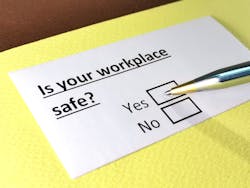What You Don’t Know CAN Hurt You
What you think you know about safety can get you hurt. When it comes to safety the person who is at risk for injury must be aware of the hazard and what can be done to control the hazard and prevent injury. The three E’s of safety are: Evaluation, Education, and Enforcement.
Evaluation
Evaluation is critical to creating a safe workplace and requires a consistent process. Many organizations consider job hazard analysis as the only evaluation. I recommend that an organization should be regularly checked against a behavioral benchmark. Important questions to ask during this phase include:
- What are executives, middle managers, and functional level employees doing to create a zero-injury environment?
- How are employees involved in the safety process?
- How can safety education and training at all levels be improved?
“Any society, organization, or team that does not enforce expected behaviors is bound to fail due to the chaos created by those who decide not to follow the expectations.”
Education
Education is meant to increase a person’s understanding of a subject. It surprises me to find organizations that repeat the same safety education and training year after year and expect improvement. It’s common to find companies that use the same script for training that has been used for 5 or 6 years. Clearly, the effectiveness of regurgitated training has long gone by the wayside.
Learning about OSHA and keeping up to date with changes can be done by purchasing an up-to-date version of OSHA General Industry Regulations and Standards updated in January 2022: https://mancomm.com/29-cfr-1910-osha-general-industry-regulations-standards-millennium-c1
Take a lead from life-long learners and suggest your team forms study groups with employees and supervisors. Safety committee members can use this book to expand their knowledge thereby positively influencing their coworkers to create a safe workplace.
Plenty of educational resources exist that can help you in getting to know safety as well. The key is to raise an overall level of safety understanding in the organization that can ultimately lead to a comfort level with enforcement.
Consider embracing the United Nation’s World Day for Safety and Health at Work as you plan for 2023. The UN shares that strong safety culture is the responsibility of all team members. So, whether you’re officially on a safety committee or not, don’t be shy to bring it to your leadership. During your company’s year-end review, suggest that the company creates some learning moments around the 2023 event. Below is wording from the UN website you could use to approach the subject with the powers that be.
“At the workplace level, a strong OSH culture is one in which the right to a safe and healthy working environment is valued and promoted by both management and workers. A positive OSH culture is built on inclusion, through the meaningful involvement of all parties in the ongoing improvement of safety and health at work. In a workplace with a strong OSH culture, workers feel comfortable raising concerns about possible OSH risks or hazards in the workplace and management is proactive in collaborating with workers to find appropriate, effective and sustainable solutions. This requires open communication and dialogue built on trust and mutual respect.”
One of my books, Who is Responsible for Safety, can help raise an overall level of safety understanding in your organization, and can ultimately lead to a comfort level that advocates for safety.
Enforcement
Enforcement is a subject that many leaders don’t like to talk about. It’s a subject that many associate with penalties, termination, and other uncomfortable consequences. Any society, organization, or team that does not enforce expected behaviors is bound to fail due to the chaos created by those who decide not to follow the expectations.
To deal with this barrier, enforcement of safe work practices should be approached as a way to solidify behavior accepted by the organization. Creating a safe work environment doesn’t mean you have to write a new rule every time someone gets hurt, but sadly many organizations react this way.
As you reflect on 2022, remember you must act when something matters to you. It’s your choice to be involved in creating a safe environment for your team. What will you do at your level of the organization? How much time will you use over the next several months to increase your knowledge about safety?
When company leaders and employees, and bargaining unit members get to know safety, they will find that it’s possible to create a workplace where nobody gets hurt. That’s something we can all live with.
ABOUT THE AUTHOR
Carl Potter, CSP, CMC, works with organizations that want to create an environment where nobody gets hurt. As an advocate for zero-injury workplaces, he is a nationally renowned safety speaker, author, and advisor to industry. He also enjoys flying and infusing aviation safety concepts into workplace safety practices. For more information, visit www.safetyinstitute.com/carl-potter or email [email protected].
(This article has been updated from one that originally ran earlier in OSP Magazine.)
About the Author

Carl Potter
CSP, CMC
Carl Potter is a certified safety professional and certified management consultant who has consulted to the industry for over 30 years. He has authored 8 books and countless articles. He is a sought-after conference speaker and consults to a variety of industries to help them achieve workplaces where it’s difficult to get hurt. He may be reached at www.carlpotter.com and you can follow him on LinkedIn: https://www.linkedin.com/in/safetyspeaker/.
